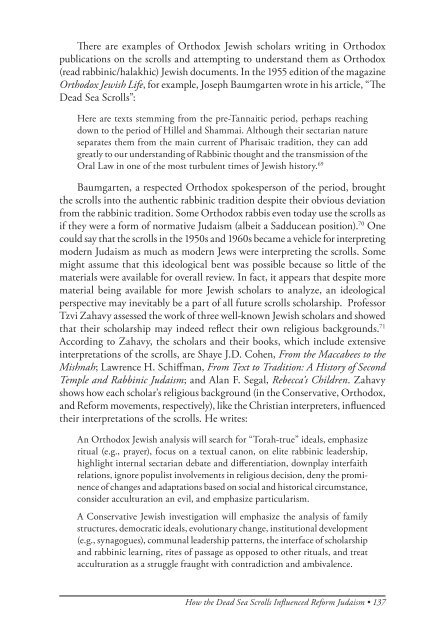The American Jewish Archives Journal, Volume LXI 2009, Number 1
The American Jewish Archives Journal, Volume LXI 2009, Number 1
The American Jewish Archives Journal, Volume LXI 2009, Number 1
Create successful ePaper yourself
Turn your PDF publications into a flip-book with our unique Google optimized e-Paper software.
<strong>The</strong>re are examples of Orthodox <strong>Jewish</strong> scholars writing in Orthodox<br />
publications on the scrolls and attempting to understand them as Orthodox<br />
(read rabbinic/halakhic) <strong>Jewish</strong> documents. In the 1955 edition of the magazine<br />
Orthodox <strong>Jewish</strong> Life, for example, Joseph Baumgarten wrote in his article, “<strong>The</strong><br />
Dead Sea Scrolls”:<br />
Here are texts stemming from the pre-Tannaitic period, perhaps reaching<br />
down to the period of Hillel and Shammai. Although their sectarian nature<br />
separates them from the main current of Pharisaic tradition, they can add<br />
greatly to our understanding of Rabbinic thought and the transmission of the<br />
Oral Law in one of the most turbulent times of <strong>Jewish</strong> history. 69<br />
Baumgarten, a respected Orthodox spokesperson of the period, brought<br />
the scrolls into the authentic rabbinic tradition despite their obvious deviation<br />
from the rabbinic tradition. Some Orthodox rabbis even today use the scrolls as<br />
if they were a form of normative Judaism (albeit a Sadducean position). 70 One<br />
could say that the scrolls in the 1950s and 1960s became a vehicle for interpreting<br />
modern Judaism as much as modern Jews were interpreting the scrolls. Some<br />
might assume that this ideological bent was possible because so little of the<br />
materials were available for overall review. In fact, it appears that despite more<br />
material being available for more <strong>Jewish</strong> scholars to analyze, an ideological<br />
perspective may inevitably be a part of all future scrolls scholarship. Professor<br />
Tzvi Zahavy assessed the work of three well-known <strong>Jewish</strong> scholars and showed<br />
that their scholarship may indeed reflect their own religious backgrounds. 71<br />
According to Zahavy, the scholars and their books, which include extensive<br />
interpretations of the scrolls, are Shaye J.D. Cohen, From the Maccabees to the<br />
Mishnah; Lawrence H. Schiffman, From Text to Tradition: A History of Second<br />
Temple and Rabbinic Judaism; and Alan F. Segal, Rebecca’s Children. Zahavy<br />
shows how each scholar’s religious background (in the Conservative, Orthodox,<br />
and Reform movements, respectively), like the Christian interpreters, influenced<br />
their interpretations of the scrolls. He writes:<br />
An Orthodox <strong>Jewish</strong> analysis will search for “Torah-true” ideals, emphasize<br />
ritual (e.g., prayer), focus on a textual canon, on elite rabbinic leadership,<br />
highlight internal sectarian debate and differentiation, downplay interfaith<br />
relations, ignore populist involvements in religious decision, deny the prominence<br />
of changes and adaptations based on social and historical circumstance,<br />
consider acculturation an evil, and emphasize particularism.<br />
A Conservative <strong>Jewish</strong> investigation will emphasize the analysis of family<br />
structures, democratic ideals, evolutionary change, institutional development<br />
(e.g., synagogues), communal leadership patterns, the interface of scholarship<br />
and rabbinic learning, rites of passage as opposed to other rituals, and treat<br />
acculturation as a struggle fraught with contradiction and ambivalence.<br />
How the Dead Sea Scrolls Influenced Reform Judaism • 137

















